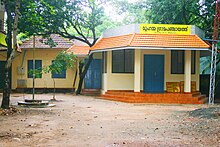Panchayati raj in India
Panchayati raj (council of five officials) is the system of local self-government of villages in rural India[1] as opposed to urban and suburban municipalities.[2] They are tasked with "economic development, strengthening social justice and implementation of Central and State Government Schemes including those 29 subjects listed in the Eleventh Schedule.[11] Mahatma Gandhi advocated Panchayati Raj as the foundation of India's political system, as a decentralized form of government in which each village would be responsible for its own affairs.The committee's recommendation was implemented by NDC in January 1958, and this set the stage for the launching of Panchayati Raj Institutions throughout the country.This amendment contains provisions for the devolution of powers and responsibilities to the panchayats, both for the preparation of economic development plans and social justice, as well as for implementation in relation to 29 subjects listed in the eleventh schedule of the constitution, and the ability to levy and collect appropriate taxes, duties, tolls and fees.[15] The Act aims to provide a three-tier system of Panchayati Raj for all states having a population of over two million, to hold Panchayat elections regularly every five years, to provide seats reserved for scheduled castes, scheduled tribes and women, to appoint a State Finance Commission to make recommendations regarding the financial powers of the Panchayats, and to constitute a District Planning Committee.Reservation of seats in Panchayati Raj Institutions is a mechanism to ensure representation of marginalized and underprivileged sections of society.Elected standing committees operate in the panchayat, focusing on specific areas like finance, development, education, health, and welfare.The absence of mandatory elections for the Panchayat council and infrequent meetings of the Sarpanch have decreased the spread of information to villagers, leading to more state regulation.[22] Many Panchayats have been successful in achieving their goals, through cooperation between different bodies and the political mobilization of previously underrepresented groups in India.[23] The reservation policy for women on the Panchayat councils have also led to a substantial increase in female participation and have shaped the focus of development to include more domestic household issues.Even though the bureaucracy was all male dominated, Gandhi hoped that Panchayati raj could be the framework for a free Indian political order.


Local government in IndiaPanchayat (disambiguation)Politics of IndiaConstitutionAmendmentBasic structure doctrineFundamental Rights, Directive Principles and Fundamental Duties of IndiaHuman rightsJudicial reviewTaxationUniform Civil CodeGovernmentPresident of IndiaDroupadi MurmuVice President of IndiaJagdeep DhankharPrime Minister of IndiaNarendra ModiCabinet secretaryRajiv GaubaMinistriesMinistersDepartmentsSecretariesParliamentLok SabhaSpeakerOm BirlaDeputy SpeakerLeader of the HouseLeader of the OppositionRahul GandhiSecretary GeneralRajya SabhaMembersChairmanHarivansh Narayan SinghJagat Prakash NaddaMallikarjun KhargePramod Chandra ModyMinistry of Parliamentary AffairsCabinet MinisterKiren RijijuMinister of StateArjun Ram MeghwalL. MuruganLaw and judiciaryLaw of IndiaIndian criminal lawBharatiya Nyaya SanhitaBharatiya Nagarik Suraksha SanhitaBharatiya Sakshya AdhiniyamCode of Civil ProcedureSupreme Court of IndiaChief JusticeDhananjaya Y. ChandrachudJudgesBar AssociationBar CouncilDistrict CourtGram NyayalayaHigh CourtChief JusticesLok AdalatNyaya PanchayatPendency of court casesOther tribunalsMinistry of Law and JusticeMinisterAttorney-GeneralR. VenkataramaniSolicitor GeneralTushar MehtaAdditional Solicitor GeneralLaw CommissionNational Judicial Appointments CommissionNational Legal Services AuthorityElections and politicsElection CommissionChief Election CommissionerRajiv KumarElection CommissionerGyanesh KumarSukhbir Singh SandhuState Election CommissionElectionsElectoral CollegeElectronic votingPresidential electionsVice Presidential electionsLok Sabha electionsConstituenciesRajya Sabha electionsState Assembly electionsPolitical partiesAdministrative divisionsStates and union territoriesCapitalsStatesAndhra PradeshArunachal PradeshChhattisgarhGujaratHaryanaHimachal PradeshJharkhandKarnatakaKeralaMadhya PradeshMaharashtraManipurMeghalayaMizoramNagalandOdishaPunjabRajasthanSikkimTamil NaduTelanganaTripuraUttar PradeshUttarakhandWest BengalUnion territoriesAndaman and Nicobar
